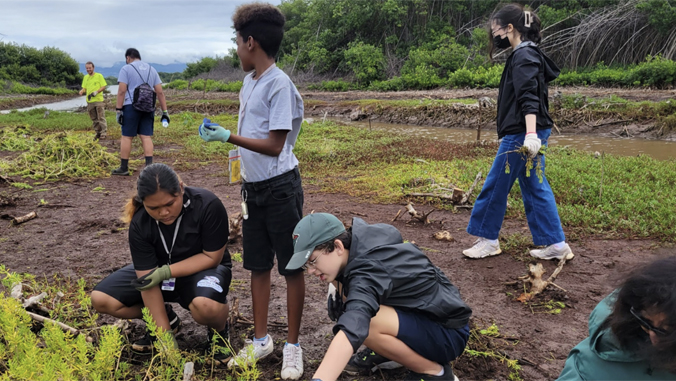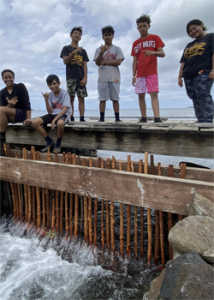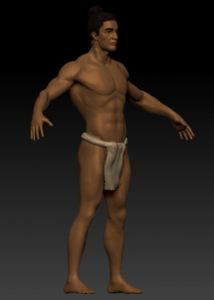
Approximately 75 University of Hawaiʻi at Mānoa undergraduate students showcased their projects at the 2023 Summer Undergraduate Research Experience (SURE) Symposium on August 4. Hosted annually by the Undergraduate Research Opportunities Program (UROP), the nine-week summer research and creative work program culminated with hybrid oral presentations in Kuykendall Hall and over Zoom, and poster presentations at the Campus Center Ballroom.
Culturally responsive education system

Sarah Rice and Tristan Fleming-Nazara’s research project, “Creating A Culturally Responsive Education System and Equitable Outcomes through Hawaiʻi-Based Learning Opportunities,” is based on the idea that to sustain the academic growth of K–12 students in Hawaiʻi, there must be an effort to consider the historical contexts and persistent inequities throughout the islands and within Native Hawaiian and Pacific Islander communities through practices, projects, programs and policies. They showcased their project during the symposium’s oral presentation session.
Under the mentorship of Professor Kealiʻi Kukahiko, Rice and Fleming-Nazara worked with the Hawaiʻi Department of Education (HIDOE) focusing on schools that engaged in the Office of Hawaiian Education’s ʻĀina Aloha program in 2022–23. They examined the schools’ implementation of a more culturally responsive education system through the assessment of written narratives, competency surveys and focus group findings.
Their findings explored the extent to which engaging in experiential academic and civic opportunities connected students to place, community, culture and language with a measurable impact on the outlined goals in the DOE Strategic Plan. Rice and Fleming-Nazara discovered that the ʻĀina Aloha program created opportunities for students to experience place-based learning and emphasized engaging, participatory lessons that are accessible to students regardless of background or circumstance.
“We recognize that Indigenous practices and ancestral knowledge hold value that can promote progress toward the stated goals of Hawaiʻi‘s schools,” Rice said. “All those receiving an education, pre–K through PhD, on this ʻāina can benefit from connection to ʻŌlelo Hawaiʻi (Hawaiian language), Kuanaʻike (Hawaiian perspective) and Pilina Honua (Relationship to ʻāina).”
Rice is a senior and presidential scholar, majoring in social work with a certificate in women, gender, and sexuality studies. Fleming-Nazara is a senior double majoring in Hawaiian studies and ʻŌlelo Hawaiʻi.
Creating art from cultural stories

Adam Joseph Parrilla’s creative work project, “Weaving Cultural Narratives into Art: Character Design Inspired by Hawaiian Moʻolelo (stories),” revolves around the cultural significance of preserving Native Hawaiian moʻolelo through the art of character design. Parrilla presented his project in the symposium’s poster session.
Mentored by Hawaiian Language Professor Matthew Kainoa Wong, Parrilla chose the story of “Ke Kumu ʻUlu Mua Loa,” which depicts the Hawaiian akua (deity) Kū coming to Hawaiʻi in human form and raising a family. During a season of drought, he sacrifices his body and is unable to return to his family to grow the ʻulu (breadfruit) tree, which has continued to be not only a staple of Native Hawaiians, but also a symbol of perseverance and kinolau (embodiment) of Kū.
“My main hope for this project was to inspire an appreciation for Hawaiian culture and moʻolelo by connecting it to something you’re interested in,” Parrilla said. “With this project, I wanted to create a good character design from this story I enjoyed. However, if this project could give anyone interested in Hawaiian stories or culture a reason to integrate what they are learning in school, that would be amazing.”
Parrilla is a senior majoring in information and computer science and art studio, and pursuing a certificate in creative computational media.
“I would encourage other students to pursue their passions, seek mentorship and look for opportunities like these for growth and learning.”
—Adam Joseph Parrilla
“This experience has been invaluable, improving both my artwork and project management skills,” Parrilla said. “I would encourage other students to pursue their passions, seek mentorship and look for opportunities like these for growth and learning. Find ways to take your knowledge and skills developed in school and apply them through programs such as these.”
UROP funding support
Both projects received UROP project funding. Each year, UROP awards more than $500,000 in merit-based scholarships directly to students to support faculty-mentored undergraduate research and creative work projects and presentations.
The SURE Symposium is one of several regular on-campus venue presentation venues organized/co-organized by UROP. During the fall and spring semesters, UROP co-organizes the Undergraduate Showcase with the Honors Program.
—By Marc Arakaki

